BenQ W2710i Review
A worthy successor to one of BenQ’s most successful models
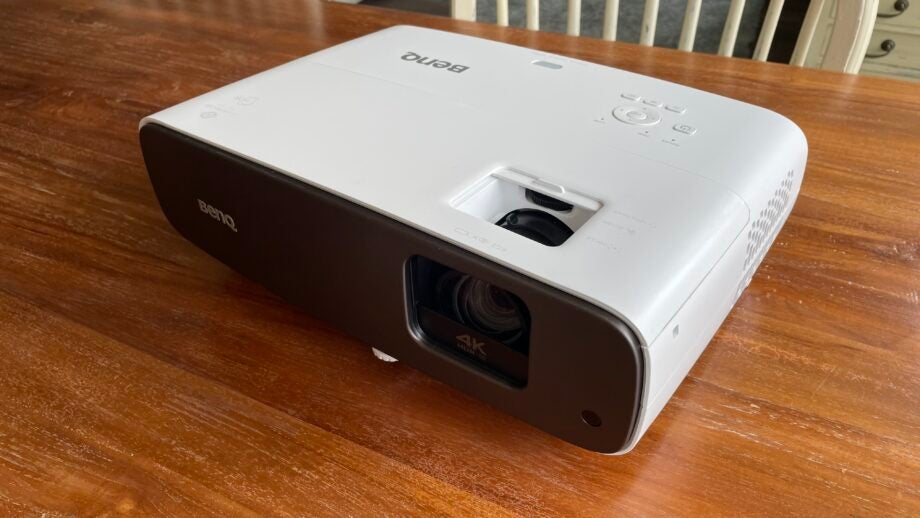

Verdict
Sensational sharpness, colour and contrast for the money makes the W2710i a worthy successor to one of BenQ’s most successful models.
Pros
- Outstandingly sharp, detailed 4K pictures
- Superb colour handling right out of the box
- HDR10+ playback
Cons
- Hyperactive ‘High’ dynamic iris setting
- Minor rainbow effect
- Mixed bag smart system
Key Features
- DLP optical systemReflects light from a lamp or laser source off an array of tiny, individually controllable mirrors
- Android TVThe ‘i’ version of the W2710 ships with Android TV dongle
- Built-in Trevolo sound systemBenQ’s specialist TreVolo audio division contributes sound system
- Local Contrast EnhancerBreaks the image down into 1000+ zones for analysis and gamma adjustment
- HDRSupports HDR10, HLG, HDR10+ formats
Introduction
BenQ’s W2700 projector became something of a classic model on its release, thanks to its combination of ‘serious’ home cinema pictures, good connectivity and an affordable mid-range price.
That W2700 release was way back in 2019. So even if I assume that BenQ took a ‘if it ain’t broke, don’t fix it’ approach to the W2700. it’s fair to say a successor is long overdue.
Happily, that successor is finally here in the W2710i. But is this just a revamp for revamping’s sake, or does it bring something new to the mid-range projector party?
Availability
- UKRRP: £1699
- USARRP: $1699
- EuropeRRP: €1899
- CanadaTBC
- AustraliaTBC
The BenQ W2710i arrived in the UK in early May 2023, hitting these shores a few weeks earlier than its US equivalent, the HT3560i. It will eventually be widely available globally under one model name or another, though.
Pricing is £1,699 / $1,699, which places it firmly in lower mid-price territory for a projector capable of playing 4K HDR sources. It’s slightly more expensive than its predecessor, but as well as this being an inevitable result of recent economic events, the ‘i’ bit at the end of its name alerts to the fact that the version I’m testing ships with an HDMI dongle that introduces an Android TV smart system to the projector’s feature set.
If you would rather just have the projector without the smarts, you can get a W2710 (without the i) for £100 less.
Design
- Hidden smart adaptor bay
- Crisp white and grey finish
- Nicely rounded shape suits living rooms
For the most part, the W2710i follows the same living room-friendly design template BenQ has used for many years now. It combines a reasonably compact rectangular design that should fit comfortably onto almost any coffee or side table with soothingly rounded edges and a crisp white finish for its top and sides. This mostly white finish is then offset by a tasteful grey for its rear and front edges.
The W2710i’s lens is offset to the projector’s right side as you look at it, and there’s a sliding cover over a small window on the top edge that provides access to simple rotating zoom and focus adjustments, as well as a wheel to shift the image vertically up or down.
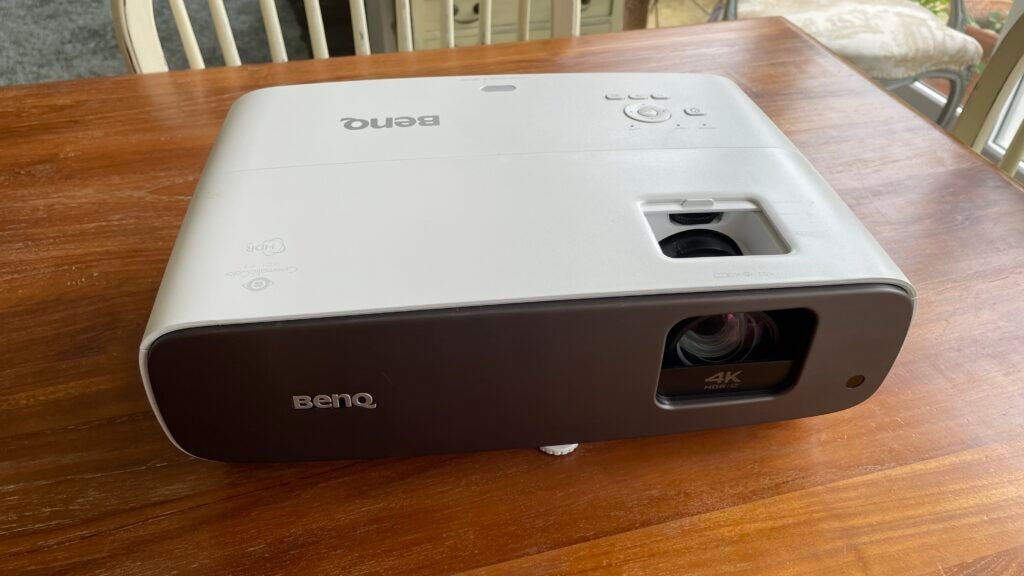
The top edge plays host to a simple selection of control buttons, while the bottom edge features three screw-down feet to help you angle the image correctly onto a screen or wall, though I really would recommend a screen for a projector as talented as this.
The W2710i’s remote control is a large, white affair with reasonably spacious buttons. The buttons are crisply and helpfully backlit too.
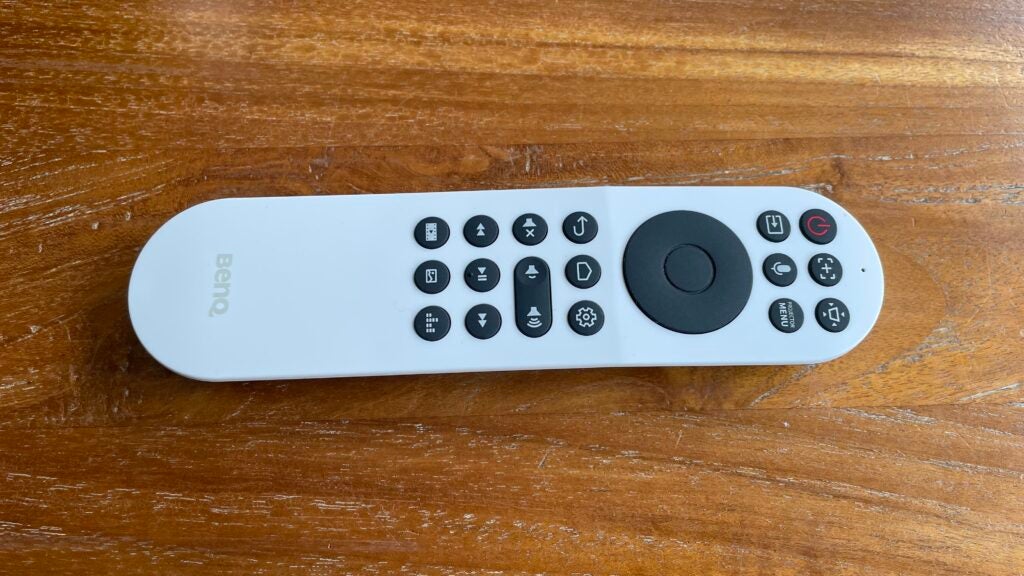
Features
- DLP-based 4K HDR playback
- Built-in smart system
- 2,200 Lumens peak brightness
The W2710i joins its predecessor in support for 4K and high dynamic range (HDR). Some will quibble over the 4K designation given that, as with all home DLP-type projectors, the W2710i doesn’t offer a full 3840 x 2160 set of mirrors, instead ‘flashing’ the mirrors multiple times a frame to generate the impression of a 4K experience.
The US’s main consumer electronics standards body, the CTA, is content to consider this approach native 4K, and the W2710i’s performance makes a very strong case for it delivering the real 4K deal.
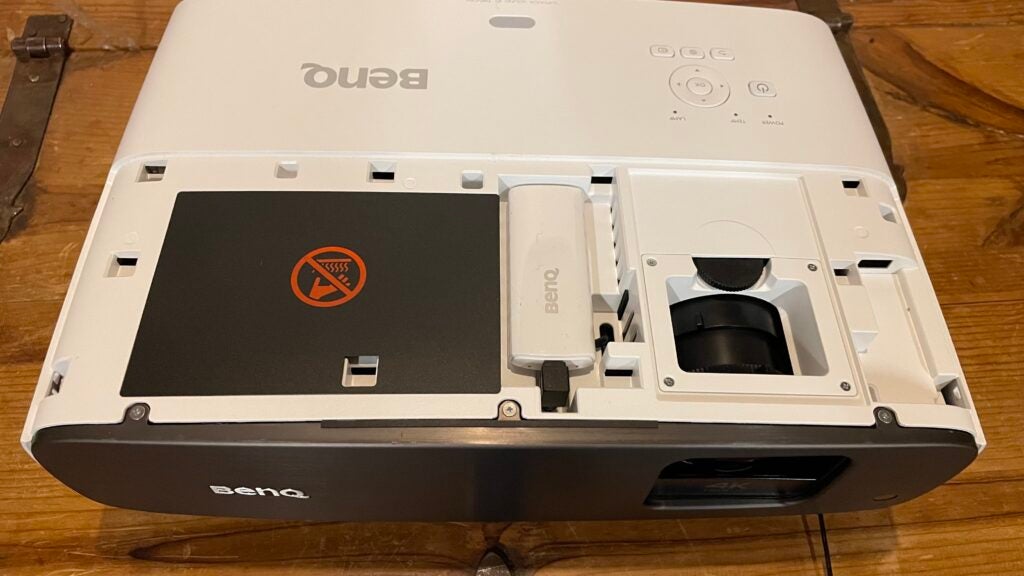
The W2710i also joins its predecessor in benefitting from BenQ’s CinematicColor system, which combines waveform analysis with special colour wheel materials and at-factory calibrations to deliver accurate pictures right out of the box.
The W2710i is claimed to cover 95% of the DCI-P3 digital cinema colour range, and a full 100% of the SDR Rec 709 spectrum.
Despite 3D sources being hard to find, the W2710i continues to support 3D playback (provided you sort yourself out with the necessary glasses). It also follows its predecessor in using a dynamic iris to enhance contrast and try to deliver a superior HDR performance courtesy of BenQ’s HDR Pro technology.
This uses dynamic tone mapping – something by no means a given in the mid-range 4K projector market – to try and continually optimise an HDR source so that it’s always getting the maximum benefit from the projector’s capabilities.
The latest HDR Pro system introduces a couple of key new features, starting with Local Contrast Enhancement. This divides the picture up into more than 1000 zones, the content of each is analysed before having its gamma independently optimized. This is still a far cry from the sort of local light controls found on premium TVs, but if it works anything like as well as the somewhat similar (on paper, anyway) system Sony uses on its latest SXRD projectors, it could give the W2710i a clear HDR edge over its rivals.
The other big HDR advance is the HDR10+ format, where extra scene-by-scene picture information is added to the video stream to help compatible displays deliver more accurate (and usually more dynamic) results. BenQ’s widened HDR horizons don’t extend to Dolby Vision, but that’s true of almost every other projector.
The W2710i also ups its game over its predecessor by increasing its peak light output to 2,200 ANSI Lumens – an increase of 10% on the W2700. The new projector introduces an 11-point colour temperature calibration system too, despite every W2710i being calibrated in the factory before shipping (a calibration certificate for your particular model is included in the box).
A ramped up CinemaMaster section of the set up menus allows you to adjust a Color Enhancer feature, Flesh Tones, a Pixel Enhancer 4K sharpness booster, various levels of motion processing, and multiple settings for the new Local Contrast Enhancer.
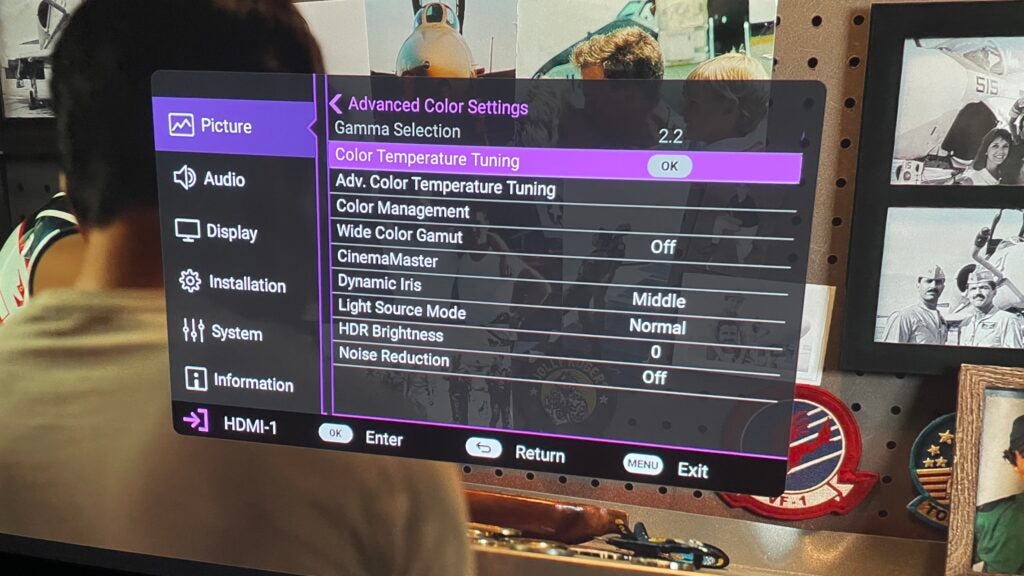
Other notable features include a special 24p True Cinema playback mode tucked away in the Display sub menus; a Wide Colour Gamut option that extends the projector’s colour palette at the cost of some brightness; multiple ‘strength’ settings for the projector’s Dynamic Iris and light output controls; and a noise reduction system. This all adds up to a far-ranging but also impressively granular level of control over exactly how the W2710i’s images look.
If these options all sound a bit too much and you’d rather have a shortcut to a relatively accurate image, you’ll be pleased to hear that BenQ has provided a Filmmaker mode preset, designed in conjunction with the independent Ultra HD Alliance to get as close as the projector can to picture mastering standards.
I found the W2710i a breeze to set up. Its 1.3x optical zoom and optical vertical image shifting gives you a decent degree of placement flexibility (though note this is certainly not an ultra short throw projector), while an effective auto keystone adjustment helps to get the edges of the image straight if the vertical image shifting hasn’t been enough to get the image to where it needs it to be.
The focus and zoom rings around the lens are loose enough to move easily but still feel quite tightly calibrated, and the three twist down feet give a quick and simple way to tilt the image.
You can spend as much time after this playing with the W2710i’s many fine tuning elements – but crucially for a living room projector, you don’t have to. Especially as the projector has been calibrated (albeit only in a factory rather than for your specific room set up) before it even arrived at your house.
As you’d hope of any living room projector these days, even one as movie-focused as the W2710i, the picture options include a so-called Fast mode for video games that reduces the time taken to render images down to a very respectable 18ms.
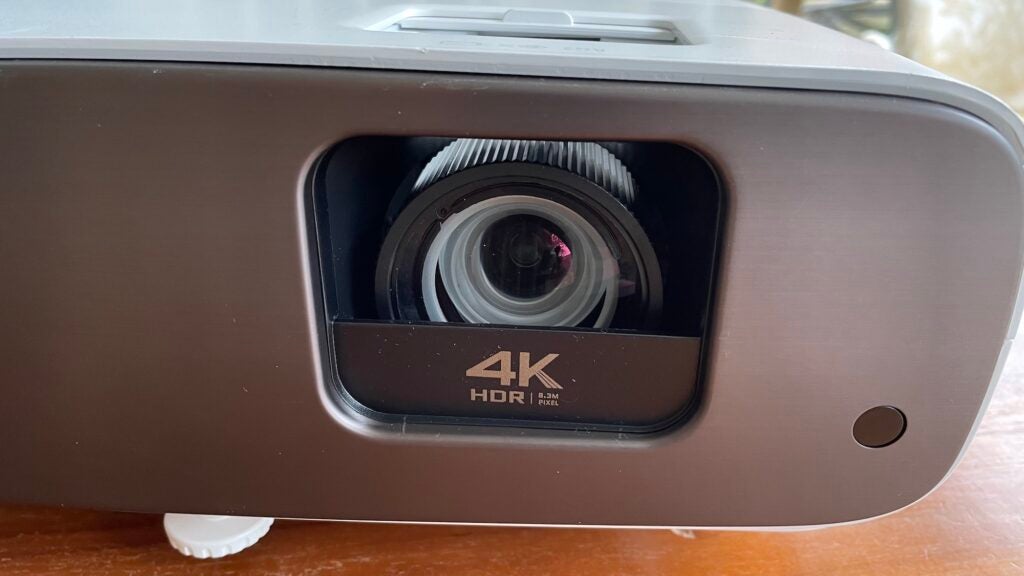
Connectivity is mostly excellent. Particularly good is the provision of three HDMI inputs than the usual two. And these don’t include the extra mini-HDMI hidden under a removable cover to which you attach BenQ’s Wi-Fi/smart dongle if you’ve gone for the ‘i’ version of the W2710.
There’s also a 12V trigger port, an RS232C control port, a USB port for playing media from USB storage devices, a Mini USB service port, a further 5V USB port for powering video dongles, an optical audio input, and a 3.5mm audio line out.
You can use the Wi-Fi capabilities introduced by the BenQ smart dongle to stream media from your phone with Google Cast.
I should note for gamers that the HDMI inputs don’t support 4K/120Hz signals, or variable refresh rates. The only advanced HDMI feature aside from HDR10+ support, is ARC, enabling pass through of sound – including (lossy) Dolby Atmos – to ARC-enabled soundbars and AV receivers.
The latest trend in projection is adding smart video systems that’s now standard with today’s TVs. The W2710i provides Android TV courtesy of a provided dongle inserted into a special bay hidden under the projector’s top edge. I found this smart interface delivers a mixed bag of functionality, though.
On the upside is the same familiar menu structure (albeit running a bit more sluggishly than it does on some of the latest Android TV devices), and available apps appear to include Disney+, Netflix, ITVX, Amazon Prime TV, Now, Apple TV, Plex, Pluto TV, YouTube, My5 and Paramount+.
There’s no BBC iPlayer or All4, though, and trying to boot ITVX resulted in a message saying the projector doesn’t have the necessary rights to use it.
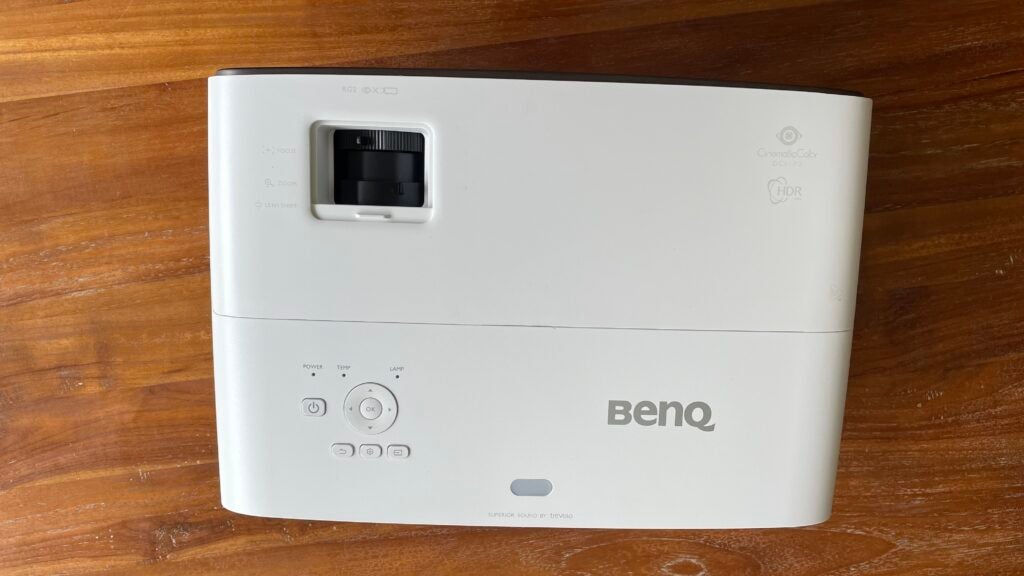
The apps that work are native to the projector, by which I mean they recognise the W2710i’s capabilities and adapt their streaming quality accordingly, rather than just accessing ‘dumb’, low quality generic internet streaming versions.
The missing terrestrial TV broadcaster streaming apps, though, make an argument for maybe getting the version of the W2710 without the provided smart dongle, and adding something like a Fire TV stick instead. Though of course, such a third party dongle would have to hang out of the back of the projector, rather than tidily tucked into the BenQ’s hidden bay.
Picture Quality
- Exceptional sharpness
- Good out of the box colour
- Good HDR tone mapping
The W2710i improves on the performance of its predecessor in a number of areas – and in doing so makes itself easily one of the best projectors in its class.
There are many highlights, but the one that actually struck me first – and remained consistently dazzling throughout the time I spent with the projector – is how incredibly sharp and detailed its pictures look. Good quality native 4K sources look absolutely pristine, packed with detail and textures no HD image could give you, while also remaining consistently bereft of softening noise or local focus failings. In fact, focus uniformity is excellent right into the corners.
It even continues to make its 4K mark if you’re watching a HD source, thanks to some impressive upscaling. In short, the W2710i presents a seriously stiff challenge to anyone still holding on to the idea that DLP projectors can’t deliver a true 4K experience.
The stunning sharpness doesn’t take a hit when there’s motion to deal with, either. The W2710i’s 24p True Cinema option serves up one of the most natural and relaxed looking 24p experiences I’ve seen on any projector – never mind one that costs £1,699.
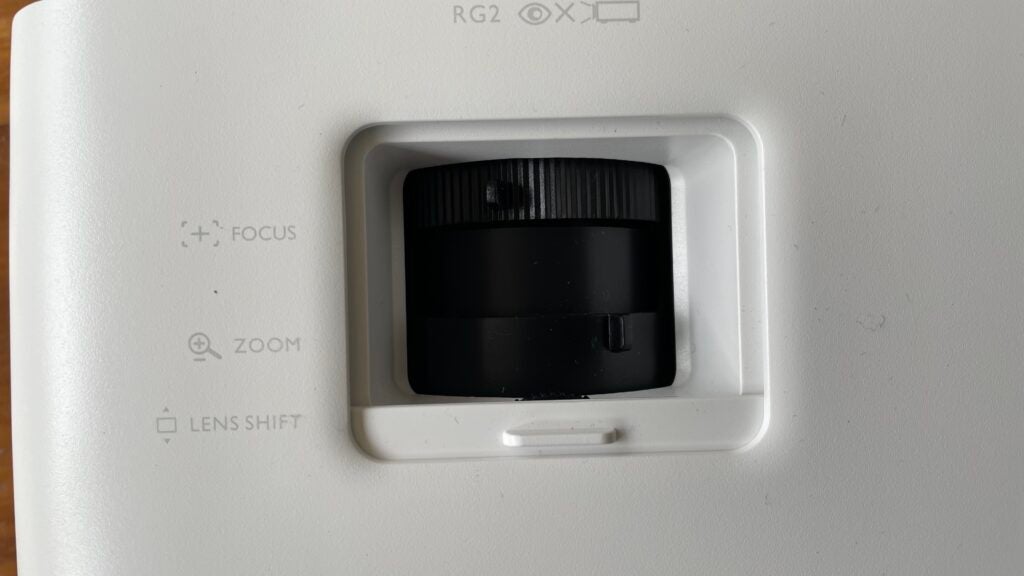
Also exceptional for such an affordable projector is the W2710i’s out of the box colour performance. This is particularly true with standard dynamic range sources, but HDR tones enjoy more vibrancy and volume than I’ve seen on similarly priced projectors.
There’s an immense amount of tonal subtlety at play within these fulsome saturations, so there’s no issue with colour banding and the rich saturations don’t feel cartoonish. On the contrary, it’s partly because the W2710i is good at delineating even the most minor colour variances that its pictures look so detailed and sharp.
As well as being punchy but clean and refined, the W2710i’s colours are also unusually natural and believable out of the box, and there’s a lovely balance to its palette, even using the default picture presets rather than something more accurate like the Filmmaker mode.
At this point I need to mention that projection technology can’t really do HDR properly. It doesn’t have the brightness or local light controls necessary to cope with HDR’s vastly expanded light range. With that in mind, the W2710i’s combination of a dynamic iris, new Local Contrast Enhancement feature and improved HDR tone mapping help it deliver arguably the most convincing and engaging HDR performances I’ve seen from a project that can be used for occasional movie nights.
There’s a very noticeable sense of extra colour and light range as I switched between SDR and HDR sources, and the new HDR Pro system maps HDR imagery to the projector’s impressive optics cleverly, ensuring that as well as looking like it has brighter peaks than expected from a 2,200 lumens projector, its HDR effects always look balanced, organic, and as if they’re a genuine expansion of rather than distraction from the pictures viewed.
Skin tones can perhaps look a little suntanned in the projector’s out of the box HDR mode, and correcting for this by either tinkering with the projector’s expansive colour calibration tools or switching to the Filmmaker mode can cause a slight drop off in general vibrancy and dynamism. It’s also true that if you try to calibrate the W2710i’s HDR pictures for accuracy, the picture starts to look a little lifeless and flat compared to its out of box settings.
Indeed, the Filmmaker mode proves my point by looking less bright, less dynamic, less contrasty and, perhaps as a result of some of the reduced contrast, less sharp and detailed than the default HDR preset.
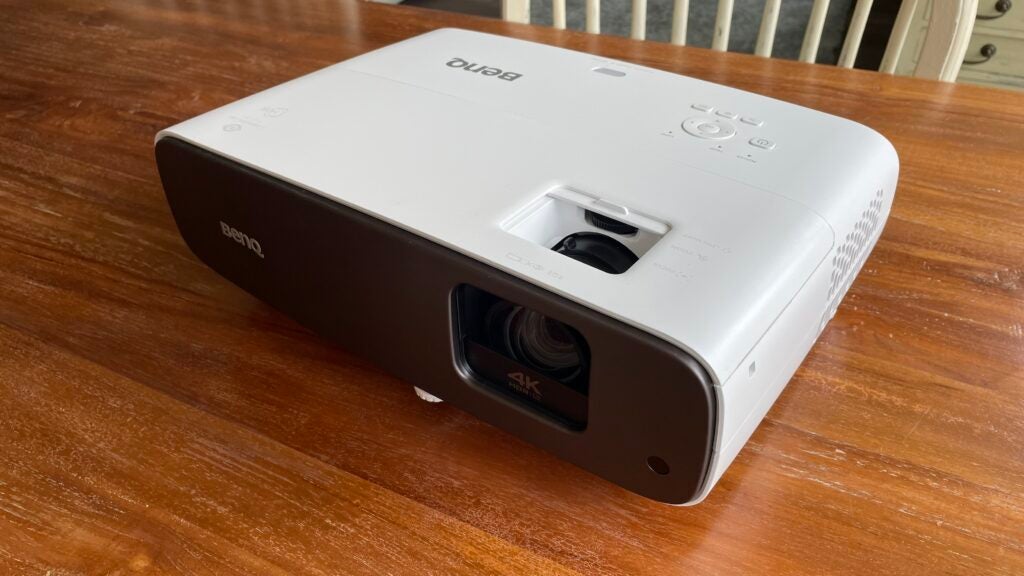
I personally don’t have a big issue with this, though. To me, the innate, insurmountable difficulties projectors have doing HDR ‘accurately’ mean trying to pursue such accuracy ultimately feels like a fools errand. The most successful HDR pictures I’ve seen in the projector world occur when models accept their limitations and focus more on doing what they can within those limitations to recapture the feel of HDR, with its extended light range and vibrant colours, rather than trying to slavishly track the values used during mastering.
And for me, no dark-room projector brand in the sub-£2k sphere does a better job of targeting that HDR feel than the W2710i. In fact, BenQ’s latest HDR enhancements are so effective that it’s frequently hard to believe you’re not watching a much brighter projector than 2,200 ANSI Lumens.
That said, I should stress the brightness isn’t enough to make the W2710i a really satisfying option for a bright living room. It’s also true to say that even the Local Contrast Enhancement feature can’t stop very dark parts of HDR images sometimes looking a little flat and greyed over. Even localised Gamma controls apparently can’t provide the sort of compromise-free blacks, whites and everything in between that HDR TVs – especially OLED TVs – can.
BenQ has never claimed the W2710i is designed for bright room use, though. If you want something to cater for a bright room BenQ would doubtless point you towards its new 3,200-lumen TK860i instead (look out for that review). And while black levels take a hit when the W2710i is playing HDR, that hit is less severe than it tends to be with projectors at the W2710i’s level. It helps disguise this issue with the W2710i, too, that shadow detail is generally strong – provided you’re using the Local Contrast Enhancement feature.
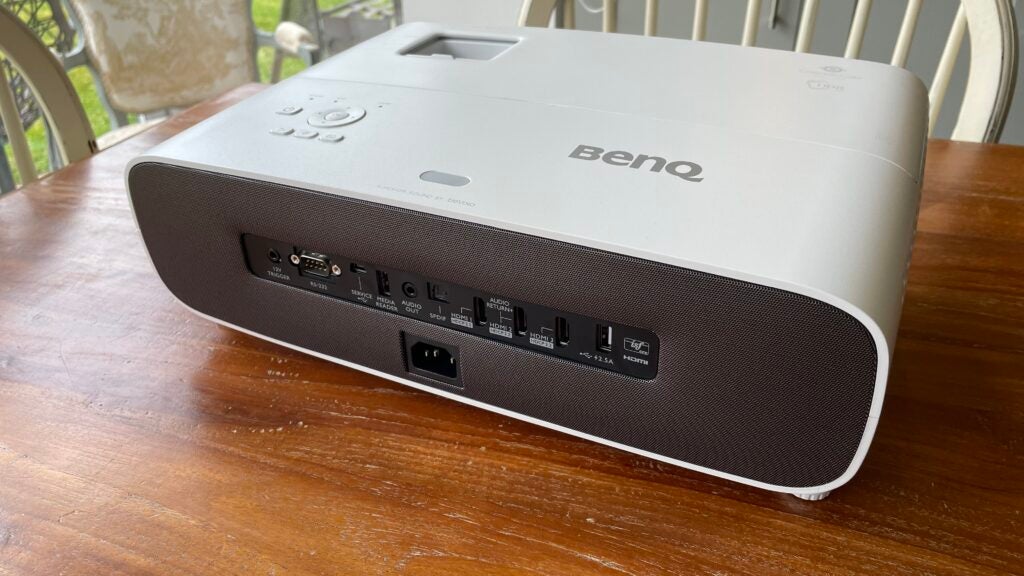
The biggest issue I had with the W2710i’s HDR pictures out of the box was their instability with HDR sources. The slightest change in the overall brightness level of an HDR scene could cause a distracting shift or jump in the image’s overall brightness level. And to be clear, I’m not talking here about significant brightness adjustments between cuts, where you might notice them less. You can actually see the dynamic iris doing its brightness adjustment thing within a single shot – often multiple times.
Fortunately there’s a straightforward fix for this distracting problem (besides switching to the less dynamic Filmmaker mode preset): Turning the Dynamic Iris down from High to Medium. Doing this doesn’t remove every flicker, and also costs you a modicum of punch and HDR ‘peaking’. The results are much more immersive though, and the slight reduction in punch is not remotely enough to stop the picture from still delivering enough of its detail, sharpness, colour and vibrancy talents to maintain its HDR edge over its competition.
Final minor issues to note are some mild rainbow effect (RGB colour striping) over stand out bright image content; some strangely mixed picture quality from the BenQ dongle’s streaming apps (Netflix looks rather messy, while Disney+ looks excellent); and potentially slightly distracting amounts of cooling fan noise when the projector’s running in its HDR mode.
Unless you’re extremely susceptible to seeing the rainbow effect, there’s nothing in the negatives column that severe enough or impossible to work round that stops it being a superb successor to an already illustrious predecessor.
Sound Quality
- Nice, rounded tone
- Sound isn’t locked to the projector
- 2 x 5W output
In support of its living room projector status, the W2710i carries a built-in sound system. In fact, its 2 x 5W, Trevolo set up is one of the projector world’s better audio designs. That’s not saying a great deal given how puny most projector sound systems are, but the W2710i delivers a much more well rounded (including with dialogue), less harsh and, most usefully of all, well projected sound than most projectors do.
If you’re sat reasonably behind the projector its sound does almost appear as if it’s coming from the screen, or at least somewhere between the projector and the screen, rather than all the sound being locked in the projector and so totally divorced from the onscreen action.
Latest deals
Should you buy it?
You want an affordable 4K HDR projector for a darkened living room: With its excellent HDR and SDR performance, easy set up and remarkable 4K sharpness, the W2710i is an excellent but also convenient living room (rather than dedicated movie room) solution.
You’re looking for a bright room projector: The W2710i’s image is configured for dark room use, and isn’t quite bright enough to support daytime viewing.
Final Thoughts
BenQ may have taken its own sweet time to update its popular W2700 living room home cinema projector, but the wait has been worth it. The W2710i’s Improvements to colour, sharpness and light control contribute to an outstanding viewing experience for its money. Even its sound is a cut above the projector norm, and joins an easy set up system in making the W2710i as friendly to use as it is impressive to watch.
There are better (as in, much brighter) options, perhaps, if you’re looking for a projector to use in a typically bright room. You might want to think about going for the cheaper W2710 if you have a separate streaming device to attach to it. For home cinema fans looking to take movie nights to another level without spending a fortune, the W2710i is an outstanding option.
How we test
We test every projector we review thoroughly over an extended period of time. We use industry standard tests to compare features properly. We’ll always tell you what we find. We never, ever, accept money to review a product.
Find out more about how we test in our ethics policy.
Tested with real world use
Tested for more than a week
FAQs
DLP projectors work by shining light from a lamp or laser onto an array of individually controlled tiny mirrors placed on the back of a controller chip.
HDR10+ is a so-called ‘active’ type of HDR that adds extra scene by scene picture information to help HDR10+ displays deliver better picture quality.
This is a smart TV system designed by Google that provides an interface for video streaming and gaming apps.
Full specs
Sustainability
Trusted Reviews’ holds the fact that global warming is not a myth as a core value and will continuously endeavour to help protect our planet from harm in its business practices.
As part of this mission, whenever we review a product we send the company a series of questions to help us gauge and make transparent the impact the device has on the environment.
We currently haven’t received answers to the questions on this product, but will update this page the moment we do. You can see a detailed breakdown of the questions we ask and why in our sustainability info page.







